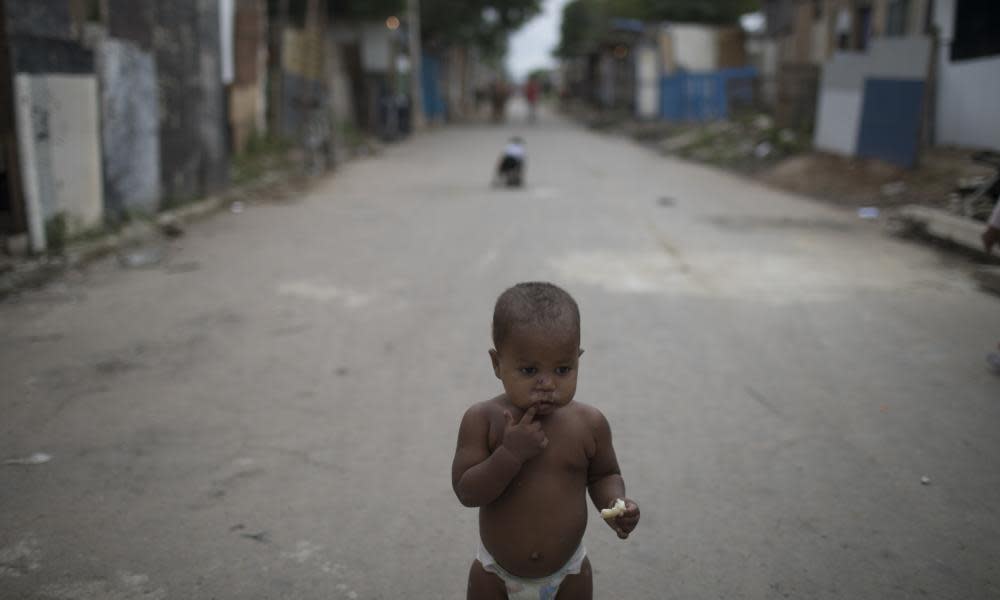Zika and health cuts blamed for rise in baby death rates in Brazil

The number of children dying in their first year of life has risen in Brazil for the first time since 1990.
It’s a worrying setback for a country once seen as a model of poverty reduction.
The infant mortality rate rose by nearly 5% between 2015 and 2016, an increase health officials and specialists have blamed on the outbreak of the Zika virus that year, as well as cuts to health services prompted by an economic crisis from which Brazil is struggling to recover.
Fatima Marinho, director of the non-communicable diseases department and information and analysis at the health ministry, said she expects the 2017 figures to exceed the 2015 levels.
“We are going backwards, not forwards,” Marinho said. “We cannot go on with the situation. Or we lose everything we have gained in 15 years.”
Denise Cesario, executive manager of the Abrinq Foundation, a non-profit group in São Paulo that focuses on children’s and teenagers’ rights, said: “The rate is very significant. It is very worrying if we consider that this economic crisis will still impact on social conditions for years to come.”
Infant mortality is regarded as one of the key measures of a country’s development. Brazil was praised for its success towards meeting the UN millennium development goal targets in a 2010 study published in the American Journal of Public Health, which said the country had made “rapid strides in improving maternal, newborn, and child health”.
But government figures for 2016 revealed by the Folha de S Paulo newspaper, and since published by the health ministry, showed that Brazil’s infant mortality rate rose from 13.3 deaths per 1,000 live births in 2015 to 14 deaths per 1,000 live births in 2016, a 4.8% increase and the first since the current system of tracking progress began in 1990.
Even relatively affluent states like São Paulo showed a 2.7% increase. Nationally, the death rate for children up to the age of five also rose nearly 4%.
Brazil had been lauded for combining economic growth with poverty reduction via landmark government programmes like the Bolsa Família – or family allowance – a cash-transfer scheme for families who made sure their children remained in school and were up to date with vaccinations.
In 2014, however, the country fell into recession. Faced with a deficit after winning re-election, President Dilma Rousseff began to cut spending and in 2016 the budget for Bolsa Família failed to match inflation.
Funding was slashed for the Rede Cegonha (the Stork Network), a government health programme for women that focused on birth, postnatal health and family planning, said Cesario.
Rousseff was suspended in May 2016 and impeached three months later. Her replacement, Michel Temer, introduced more drastic cuts and froze spending.
Government officials have been so alarmed by the increase in infant and child deaths that they called a special meeting of state health secretaries in June. Deaths from preventable diseases like diarrhoea and pneumonia also rose in 2016. Folha also reported a 12% increase in deaths from diarrhoea in under-fives, with 19% of those occurring in semi-arid regions that have been battling drought in recent years.
“How can children in Brazil in the 2000s die of diarrhoea? This number is shocking,” said Marinho, noting that the birth rate fell by around 5% percent in 2016 because women were avoiding having children during the Zika epidemic.
Jurandi Frutuoso, executive secretary of the national council of health secretaries and a former health secretary of north-eastern Ceará state, said less than half of Brazil’s health spending comes from government – the rest is from private health plans and people’s own pockets – and spending has failed to keep pace with the growing population, technological advances and medical inflation. At the same time, the proportion spent by federal government has fallen, leaving cash-strapped states and cities unable to pick up the slack.
“The system lives with very serious under-financing,” he said.
Cesario said the country’s next president must prioritise children. Temer is not standing in presidential elections in October.
“We need the next president to be committed to childhood, to understand the situation of the most vulnerable families, so we can prioritise children,” she said.

 Yahoo News
Yahoo News 
